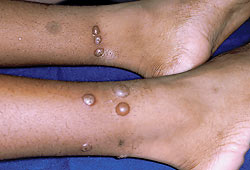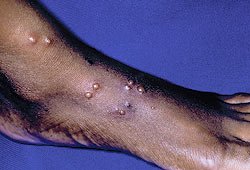A 9-year-old boy with pruritic lesions
Click Here to Manage Email Alerts
A 9-year-old healthy boy presented to the clinic complaining of a three-day history of several moderately pruritic lesions on his lower legs. This was his third episode with similar lesions this summer.

No one else in the family developed this rash, and he had not received any treatment. He spent much of his summer outdoors playing in the yard. The family had no pets, and there was no history of bed bugs. On physical exam, the dorsal aspect of the right foot has several grouped and linear 3 mm to 6 mm vesicles and one discrete 2 mm hyperpigmented excoriated papule extending to the right ankle.
Did you manage to spot the rash? Click to the next page to find out.
Answer
The diagnosis is bullous papular urticaria or insect bite-induced hypersensitivity. Papular urticaria or insect bite-induced hypersensitivity is common in children. It is caused by a hypersensitivity reaction to arthropods such as mosquitoes, bed bugs, fleas or mites. One report cited that 5% of visits to a pediatric dermatology clinic during a four-week period were for papular urticaria. Papular urticaria is caused by both immediate (type 1) and delayed (type 4) hypersensitivity after a period of sensitization. Bullae typically develop in patients with more severe hypersensitivity.
Patients report moderately to intensely pruritic lesions that initially begin as urticarial papules and progress to vesicles or bullae in one to three days. Bites are commonly found on exposed areas like the extremities and face and often spare the trunk, axilla and groin. Caused by multiple bites, papules are often grouped or linear and may be referred to as representing the bug’s “breakfast, lunch and dinner.” Lesions tend to resolve in one to two weeks, but new lesions develop as patients are repeatedly bitten. Characteristically, old lesions may be reactivated when new bites occur and may last for several months. Scratching is common because of severe pruritus and often leads to erosions and risk for bacterial super-infection. Infected lesions may leave permanent scarring. Postinflammatory hyperpigmentation and hypopigmentation can persist for months to years, especially in individuals with dark skin.
Until the child is removed or protected from the arthropods or develops tolerance, the bites will continue to occur. This may take weeks to years. It is common to see bites in only some members of the family because of the varied hypersensitivity response within each individual and to the greater preference of particular arthropods for certain individuals. There appears to be a peak in the spring and summer concurrent with increased exposure to insects; however, patients may present throughout the year in warmer climates and from exposure to indoor fleas or bed bugs.


It may be difficult to ascertain the source of the exposure, thereby making it challenging to convince parents that the eruption is caused by bites. Locating the source of the bites often requires detective work, and families may be insulted when questioned about insects or fleas in the home. If the family does not have pets, the offending arthropod may be from other pets with which the patient comes into contact; including those belonging to neighbors, other family members, a school or a day care facility. Explaining to the family that the child is “highly allergic” to insect bites often makes the family more likely to accept the diagnosis.
Skin biopsy may help confirm the diagnosis and shows spongiosis (epidermal intercellular edema), subepidermal edema and a superficial and deep perivascular and interstitial infiltrate mixed with lymphocytes and eosinophils. The differential diagnosis includes acute and chronic urticaria, atopic dermatitis, contact allergic dermatitis, drug-hypersensitivity reaction, pityriasis lichenoides et varioliformis acuta, papular acrodermatitis of childhood, neurogenic excoriations, linear IgA bullous dermatosis, lymphomatoid papulosis and, rarely, lymphoma.
Prevention for mosquito exposure includes avoiding exposure and using insect repellents such as DEET (in concentrations of less than 30%) or picaridin and wearing protective clothing when outside. Prevention and treatment for fleas include bathing pets regularly and treating them with flea collars and medication. Bedding should be washed frequently and the home vacuumed regularly. Treatment of bed bugs includes locating the source and cleaning sheets and mattress pads every two to four weeks as well as spraying the home and car with pesticides. If there is a significant bed bug infestation, old mattresses and couches may need to be discarded. Professional exterminators may be necessary to eradicate fleas and bed bugs.
Pruritus can be managed with mid; to high-potency topical steroids to individual lesions and with oral antihistamines. Topical preparations with menthol, camphor or praxomine also may be helpful. However, because of the chronic nature of the lesions, prevention and patience may be the best option until tolerance develops. Papular urticaria can be frustrating for patients and parents, especially if the families have already had an extensive evaluation or have been referred to a subspecialty clinic such as allergy or dermatology. The clinician’s ability to recognize this common disorder and explain the natural history to families may help with acceptance of the diagnosis and appropriate treatment.
For more information:
- Marissa Perman is at Cincinnati Children’s Hospital Medical Center.
- Hernandez RG, Cohen BA. Insect bite-induced hypersensitivity and the SCRATCH principles: a new approach to papular urticaria. Pediatrics. 2006;118:e189-196.
- Howard R, Frieden IJ. Papular urticaria in children. Pediatr Dermatol. 1996;13:246-249.
- Paller AS, Mancini AJ. Hurwitz Clinical Pediatric Dermatology: A Textbook of Skin Disorders of Childhood and Adolescence. Philadelphia: Elsevier; 2006:461-463.
